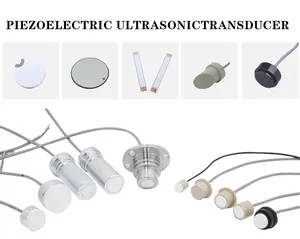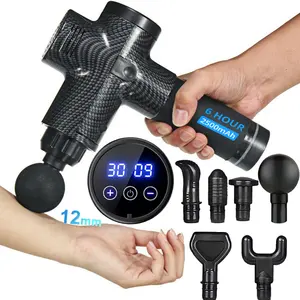Phổ biến trong ngành của bạn






Issr 25KHz siêu âm Transmitter Cảm biến phát hiện khoảng cách gốm Áp Điện Đầu dò
0,50 US$ - 0,90 US$
Đơn hàng tối thiểu: 50 Cái


Clangsonic Chất Lượng Cao Không Thấm Nước Siêu Âm 40Khz 60Watts Siêu Âm Làm Sạch Đầu Dò Giá
7,00 US$ - 20,00 US$
Đơn hàng tối thiểu: 1 Cái







Đầu Dò áp điện siêu âm 500Khz độ chính xác cao cho đồng hồ đo khí
3,00 US$ - 5,50 US$
Đơn hàng tối thiểu: 2 Cái







Nhà cung cấp Cảm biến siêu âm 16mm 40kHZ để đo khoảng cách
0,35 US$ - 1,00 US$
Đơn hàng tối thiểu: 1 Cái







Chất Lượng Cao Siêu Âm 40KHZ 28KHZ 25KHZ 110 Volt Máy Phát Điện Circuit Board Cho Các Lái Xe Siêu Âm Đầu Dò
Sẵn sàng vận chuyển
28,00 US$ - 35,00 US$
Đơn hàng tối thiểu: 1 Cái
Vận chuyển mỗi chiếc: 5,00 US$






Máy Phát Siêu Âm OEM 16Mm 25KHz Đầu Dò Cảm Biến Cho Thiết Bị Đuổi Chó
0,35 US$ - 0,80 US$
Đơn hàng tối thiểu: 100 Cái







Đầu Dò Làm Sạch Siêu Âm Cảm Biến Siêu Âm 20Khz 25Khz 28Khz 68Khz 80Khz 100Khz 120Khz 170Khz 200Khz 40Khz 60W
5,90 US$ - 15,00 US$
Đơn hàng tối thiểu: 1 Cái






Mua cảm biến rung áp điện chất lượng cao làm sạch đầu dò siêu âm đầu dò 25KHz đến 200kHz
5,50 US$ - 14,30 US$
Đơn hàng tối thiểu: 1 Cái






Đầu Dò Làm Sạch Siêu Âm 100W 25Khz Đầu Dò Siêu Âm Để Làm Sạch Bình Tĩnh Gốm Áp Điện
7,40 US$ - 7,80 US$
Đơn hàng tối thiểu: 1 Cái






25Khz 60W Điều Chỉnh Siêu Âm Làm Sạch Đầu Dò Cho Máy Làm Sạch Siêu Âm/Siêu Âm
9,00 US$ - 11,50 US$
Đơn hàng tối thiểu: 1 Cái
Các tìm kiếm liên quan:
đầu dò siêu âm 100khzđầu dò siêu âm pzt 20khzđầu dò siêu âm 80khzđầu dò siêu âm pzt4đầu dò siêu âm pzt8đầu dò siêu âm 1 4đầu dò siêu âm 20knhà máy siêu âm đầu dò 40khzđầu dò siêu âm 10mm 40khzđầu dò siêu âm 20khz 100wđầu dò siêu âm 40khz 100wđầu dò siêu âm 40kđầu dò siêu âm phạm vi 5mđầu dò siêu âm ip68đầu dò siêu âm 28khz 60w






Cảm Biến Rung Công Nghiệp Siêu Âm Piezo Giá Thấp 100W Đa Tần Số Đầu Dò Làm Sạch Siêu Âm 25Khz
Sẵn sàng vận chuyển
4,50 US$ - 5,50 US$
Đơn hàng tối thiểu: 1 Cái
Vận chuyển mỗi chiếc: 14,15 US$






Đầu Dò Làm Sạch Bằng Sóng Siêu Âm Đầu Dò Siêu Âm Cho Nhà Máy Làm Đẹp Da Mặt Chất Lượng Cao 25Khz Cung Cấp Hai Loại Màu Vàng 80Watt
8,00 US$ - 15,00 US$
Đơn hàng tối thiểu: 1 Cái






Strongfirst Nhà Máy Giá 16 Mét 25KHz cảm biến siêu âm cho khoảng cách đo khoảng cách cảm biến siêu âm đầu dò
0,32 US$ - 0,60 US$
Đơn hàng tối thiểu: 100 Cái






Cảm Biến Áp Suất Màu Vàng 15K/15Khz 4200W Langevin 20K 25Khz 28Khz Công Suất Chìm Áp Điện Siêu Âm Đầu Dò
Sẵn sàng vận chuyển
230,00 US$ - 280,00 US$
Đơn hàng tối thiểu: 1 Cái
Vận chuyển mỗi chiếc: 47,50 US$






15KHz 20kHz 25KHz 28kHz 40kHz 68kHz 80KHz 100kHz đầu dò siêu âm gốm áp điện công nghiệp
Sẵn sàng vận chuyển
8,00 US$
Đơn hàng tối thiểu: 20 Đơn vị
Vận chuyển mỗi chiếc: 2,94 US$






Đầu Dò Áp Điện Cảm Biến Siêu Âm Giá Rẻ Bằng Nhựa Đã Qua Sử Dụng Huấn Luyện Thú Cưng 16Mm 25KHZ
0,38 US$ - 0,50 US$
Đơn hàng tối thiểu: 100 Cái






Đầu dò siêu âm tần số 25kHz Đầu dò siêu âm 16mm khác nhau cảm biến linh kiện gây nhiễu chó
Sẵn sàng vận chuyển
0,38 US$ - 0,42 US$
Đơn hàng tối thiểu: 1000 Cái
Vận chuyển mỗi chiếc: 0,18 US$






Giá bán buôn 60W Đầu dò siêu âm 25KHz đầu dò làm sạch siêu âm
Sẵn sàng vận chuyển
5,50 US$ - 15,00 US$
Đơn hàng tối thiểu: 1 Cái
Vận chuyển mỗi chiếc: 34,82 US$




Bộ Chuyển Đổi Làm Sạch Siêu Âm Không Thấm Nước Cho Thiết Bị Làm Sạch Siêu Âm/Máy 20Khz 25Khz 30Khz
6,00 US$ - 15,00 US$
Đơn hàng tối thiểu: 1 Cái






25Khz 60W Bộ Phận Làm Sạch Bằng Siêu Âm Đa Dụng Áp Điện Siêu Âm Làm Sạch Transducer
5,00 US$ - 30,00 US$
Đơn hàng tối thiểu: 1 Đơn vị






Cảm biến 1625 25KHz đầu dò siêu âm Loại mở cảm biến xe 16mm cho Repeller Chuột đuổi chó côn trùng nhỏ phát hiện âm thanh
0,27 US$ - 0,75 US$
Đơn hàng tối thiểu: 1 Cái









Đầu Dò Áp Điện Siêu Âm 25Khz 100W Chất Lượng Cao Cho Thiết Bị Làm Sạch Siêu Âm 25K
Sẵn sàng vận chuyển
5,90 US$ - 6,50 US$
Đơn hàng tối thiểu: 1 Cái
Vận chuyển mỗi chiếc: 12,27 US$






20Khz 25Khz 30Khz 50Khz 60Khz 200Khz Piezo Rung Siêu Âm 28Khz Siêu Âm Đầu Dò
7,00 US$ - 20,00 US$
Đơn hàng tối thiểu: 1 Cái






Đầu Dò Piezo Cảm Biến Siêu Âm Làm Sạch Bằng Gốm 100W 25KHZ Cho Máy Làm Sạch Siêu Âm
7,50 US$ - 100,00 US$
Đơn hàng tối thiểu: 10 Cái






Skymen Đầu Dò Siêu Âm Chìm 25Khz Để Làm Sạch 1800W
1.000,00 US$ - 1.150,00 US$
Đơn hàng tối thiểu: 1 Bộ





Thiết Bị Hàn Công Nghiệp Công Suất Cao Khác Đầu Dò Siêu Âm 25Khz
85,00 US$ - 90,00 US$
Đơn hàng tối thiểu: 1 Cái






Giá Bán Buôn Máy Dò Siêu Âm Áp Điện Làm Sạch Dưới Nước Sóng Siêu Âm 15Khz 25Khz 28Khz
115,00 US$ - 1.350,00 US$
Đơn hàng tối thiểu: 1 Cái






Issr 24mm 25 KHz Micro Piezo gốm đầu dò Pin nhựa cảm biến siêu âm Transmitter 25 kHz âm thanh siêu âm đầu dò
0,50 US$ - 0,90 US$
Đơn hàng tối thiểu: 50 Cái






40kHz 80KHz 60KHz 68kHz 22Khz 120kHz 28kHz 200KHz 25KHz 50kHz 15W 20W 25W 35W 50W 60W 80W 100W Đầu dò làm sạch siêu âm
4,50 US$ - 8,50 US$
Đơn hàng tối thiểu: 1 Đơn vị






Đầu dò làm sạch siêu âm áp điện tần số kép 25KHz 100kHz PZT-8 đầu dò siêu âm langevin
9,00 US$ - 15,00 US$
Đơn hàng tối thiểu: 1 Cái






Dao động siêu âm công nghiệp/Đầu dò 25KHz 60W
Sẵn sàng vận chuyển
6,50 US$ - 7,50 US$
Đơn hàng tối thiểu: 1 Cái
Vận chuyển mỗi chiếc: 30,83 US$






Siêu âm rung siêu âm làm sạch đầu dò 25KHz 40kHz
Sẵn sàng vận chuyển
20,00 US$ - 25,00 US$
Đơn hàng tối thiểu: 10 Cái
Vận chuyển mỗi chiếc: 9,84 US$






25KHz siêu âm buzzer trí tuệ nhân tạo ngành công nghiệp đầu dò
100,00 US$ - 103,00 US$
Đơn hàng tối thiểu: 50 Cái












Siêu Âm Y Tế Debridement Phun Đầu Dò Siêu Âm Sử Dụng Cho Debridement Y Tế
145,00 US$ - 175,00 US$
Đơn hàng tối thiểu: 1 Cái






Đầu dò Máy hàn siêu âm chất lượng cao
Sẵn sàng vận chuyển
100,00 US$ - 1.000,00 US$
Đơn hàng tối thiểu: 1 Cái
Vận chuyển mỗi chiếc: 0,00 US$






Các danh mục hàng đầu
Giới thiệu về đầu dò siêu âm 25khz
Ngày nay, đầu dò siêu âm 25khz không còn là điều mới mẻ đối với những người bình thường và không còn bị coi là điều cấm kỵ khi sử dụng. Nếu bạn đang tìm kiếm niềm vui áp chót đó, bạn phải kiểm tra sự bao la. Bộ sưu tập đầu dò siêu âm 25khz tại Alibaba.com. Những gợi cảm và cong. đầu dò siêu âm 25khz đáng giá từng xu và chắc chắn làm cho đêm đó trở nên đặc biệt đối với bạn. Những con búp bê này có ngoại hình giống như thật, bắt đầu từ tóc đến ngón chân theo mọi nghĩa.
Cho dù bạn là một người cô đơn đang tìm kiếm một người bạn đời như cuộc sống hay một cặp vợ chồng muốn thêm gia vị cho cuộc sống của họ, bạn đều có thể sử dụng chúng . đầu dò siêu âm 25khz để đốt cháy ngọn lửa đó. Những ngoạn mục. đầu dò siêu âm 25khz có thể tùy chỉnh theo mong đợi của bạn. Những điều tuyệt vời. đầu dò siêu âm 25khz có sẵn ở cả phiên bản dành cho nam và nữ và được làm từ silicone cấp y tế để sử dụng an toàn. Hãy sở hữu ngay bây giờ và tận hưởng một đêm đam mê và cháy bỏng.
Alibaba.com cung cấp những điều tuyệt vời này. đầu dò siêu âm 25khz ở mọi hình dạng cơ thể, kích thước và sắc tộc. Dù yêu cầu của bạn đối với. đầu dò siêu âm 25khz, bạn có thể tải tất cả chúng trên trang web. Những cái này. đầu dò siêu âm 25khz được tạo hình bởi những người thợ thủ công giỏi nhất và mọi chi tiết phức tạp đều được kiểm tra kỹ lưỡng. Những con búp bê này có mắt, tóc, móng tay và tất cả các bộ phận cơ thể khác tương tự như người thật.
Alibaba.com cung cấp nhiều loại. đầu dò siêu âm 25khz có thể giúp bạn mua các sản phẩm phù hợp với ngân sách và các yêu cầu khác của bạn. Các sản phẩm này an toàn để sử dụng, được chứng nhận và thân thiện với môi trường trong tự nhiên. Đơn đặt hàng OEM có sẵn trên các sản phẩm này.
Cho dù bạn là một người cô đơn đang tìm kiếm một người bạn đời như cuộc sống hay một cặp vợ chồng muốn thêm gia vị cho cuộc sống của họ, bạn đều có thể sử dụng chúng . đầu dò siêu âm 25khz để đốt cháy ngọn lửa đó. Những ngoạn mục. đầu dò siêu âm 25khz có thể tùy chỉnh theo mong đợi của bạn. Những điều tuyệt vời. đầu dò siêu âm 25khz có sẵn ở cả phiên bản dành cho nam và nữ và được làm từ silicone cấp y tế để sử dụng an toàn. Hãy sở hữu ngay bây giờ và tận hưởng một đêm đam mê và cháy bỏng.
Alibaba.com cung cấp những điều tuyệt vời này. đầu dò siêu âm 25khz ở mọi hình dạng cơ thể, kích thước và sắc tộc. Dù yêu cầu của bạn đối với. đầu dò siêu âm 25khz, bạn có thể tải tất cả chúng trên trang web. Những cái này. đầu dò siêu âm 25khz được tạo hình bởi những người thợ thủ công giỏi nhất và mọi chi tiết phức tạp đều được kiểm tra kỹ lưỡng. Những con búp bê này có mắt, tóc, móng tay và tất cả các bộ phận cơ thể khác tương tự như người thật.
Alibaba.com cung cấp nhiều loại. đầu dò siêu âm 25khz có thể giúp bạn mua các sản phẩm phù hợp với ngân sách và các yêu cầu khác của bạn. Các sản phẩm này an toàn để sử dụng, được chứng nhận và thân thiện với môi trường trong tự nhiên. Đơn đặt hàng OEM có sẵn trên các sản phẩm này.

















